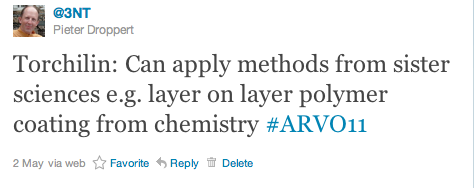Nanoparticles using layer-by-layer technology provide targeted cancer drug delivery
At the recent ARVO meeting, one of the symposia that I live tweeted from was on “Nanotechnology for Drug and Gene Delivery.” During his presentation on “Nanomedicines: From Bench to Bedside” Vladimir Torchilin from Northeastern described how nanotechnology can use methods from other scientific disciplines including layer-by-layer (LbL) polymer chemistry.
Which leads me into an interesting paper that came across my desk from Zhiyong Poon and colleagues at the Koch Institute for Integrative Cancer Research at MIT.
In their paper published online on April 23, 2011 in ACS Nano. they describe how nanoparticles with a pH-sheddable layer can be used to target tumor hypoxia.
In other words, the nanoparticle can travel in the blood to the tumor, then in the changed acidity and pH of the tumor microenvironment, the outer stealth layer is eroded and shedded, exposing another layer of the nanoparticle that delivers drug to the target hypoxic tumor region.

Image Source: ACS Nano. The author’s conclusion is that “this concept for tumor targeting is potentially valid for a broad range of cancers, with applicability for therapies that target hypoxic tumor tissue.”
This proof of principle research is further progress towards the development of nanomedicines in oncology.
![]() Poon, Z., Chang, D., Zhao, X., & Hammond, P. (2011). Layer-by-Layer Nanoparticles with a pH-Sheddable Layer for Targeting of Tumor Hypoxia ACS Nano DOI: 10.1021/nn200876f
Poon, Z., Chang, D., Zhao, X., & Hammond, P. (2011). Layer-by-Layer Nanoparticles with a pH-Sheddable Layer for Targeting of Tumor Hypoxia ACS Nano DOI: 10.1021/nn200876f
